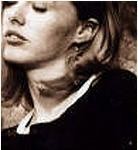Featured Poet: March 2013 Vol. 5 # 6
classid="clsid:38481807-CA0E-42D2-BF39-B33AF135CC4D" id=ieooui>
Paarl, Western Cape, South Africa
Email: viancavdv@gmail.com
Vianca Adams is a mother of four living in Paarl, Western Cape, South Africa. Adams has no formal art training or background, She started drawing because somehow it made her feel less "broken." The work you see has been created and composed of different mediums and materials. Initially, Vianca used whatever junk she found interesting and mixed bits of paints and food colouring because she is unable to afford art materials. As time passed Vianca rather enjoyed creating in this manner, "treasure hunting" in open fields, on busy streets and relatives' backyards. She is now crafting, making bowls, African drums, candle holders, cd racks etc. All from scrap!
(Click Image to Enter Gallery)
 This isn’t a new concept. In fact, it’s as old as poetry itself. Perhaps though, for the sake of this short essay, the term, which Kerry James Evans and I came up with independent of any perfunctory research, just might be: The Active Image.
This isn’t a new concept. In fact, it’s as old as poetry itself. Perhaps though, for the sake of this short essay, the term, which Kerry James Evans and I came up with independent of any perfunctory research, just might be: The Active Image.  crowded bar are implicitly conjured in the reader’s imagination. One could make that argument, I suppose, but every great poem, every great story, is about a journey not just a destination, just as every impassible gorge needs a bridge to sway between its two sides, if we are to pass. The buildup gives resonance to any revelation. And not to mention, to favor the precision of the image and scene is to spend a little extra time developing it (purposefully developing it)—that the development, the building, is essential to animating the scene.
crowded bar are implicitly conjured in the reader’s imagination. One could make that argument, I suppose, but every great poem, every great story, is about a journey not just a destination, just as every impassible gorge needs a bridge to sway between its two sides, if we are to pass. The buildup gives resonance to any revelation. And not to mention, to favor the precision of the image and scene is to spend a little extra time developing it (purposefully developing it)—that the development, the building, is essential to animating the scene. classid="clsid:38481807-CA0E-42D2-BF39-B33AF135CC4D" id=ieooui>
 Ann-Marie Brown
Ann-Marie Brown
Montreal, Canada
Email: ambpaintings@hotmail.com
Website: www.orangeartgallery.ca
Website Boxer Series: www.galeriedavignon.ca
Ann-Marie Brown is a Montreal-based painter who is building a reputation as the newest addition to the wax-painting genre. Ms. Brown spent her twenties gaining diverse experiences that included religious studies in Europe, critical theory studies in Canada, and travels to far off regions of the world including Africa, the Middle East, and East Asia. Before moving to Montreal, she spent several years on a remote stretch of coast, an hour by boat from Vancouver, immersing herself in the art and craft of her chosen medium. Ann-Marie has devoted the last decade to working professionally as a painter in oil and wax. She joins the ranks of artists who have contributed to reviving the medium’s popularity, such as fellow Canadian Tony Scherman.
(Click Image to Enter Gallery)